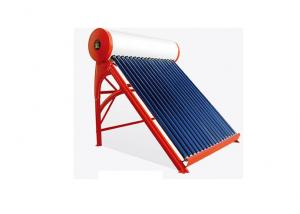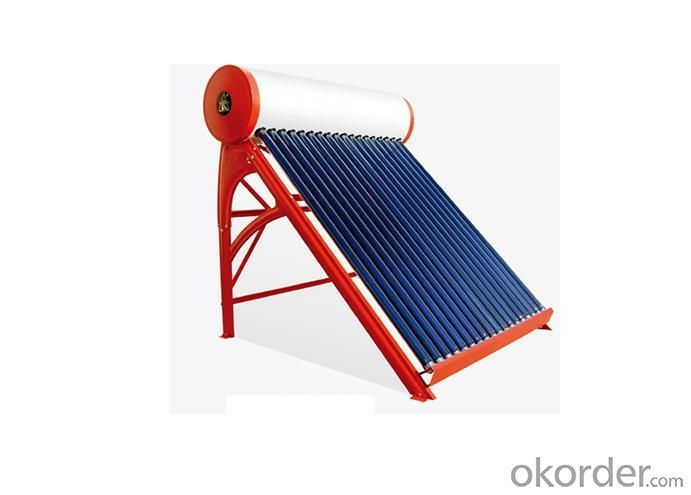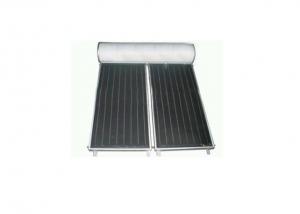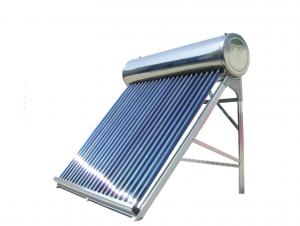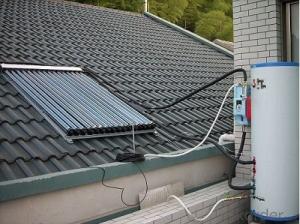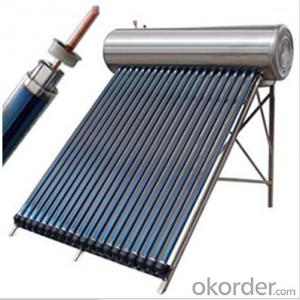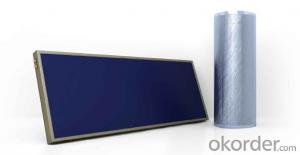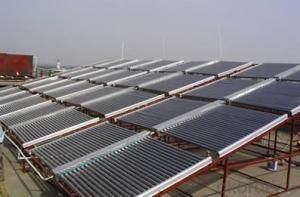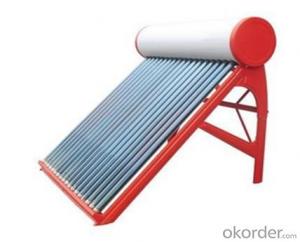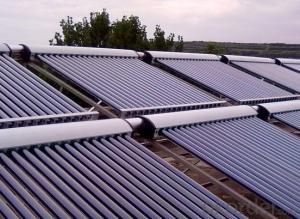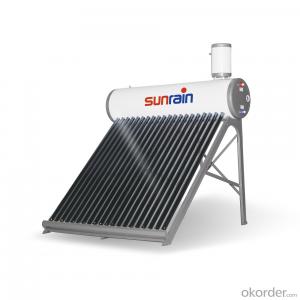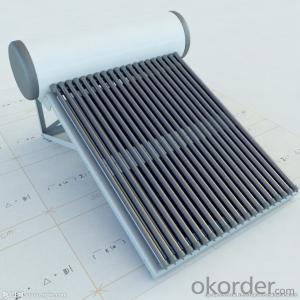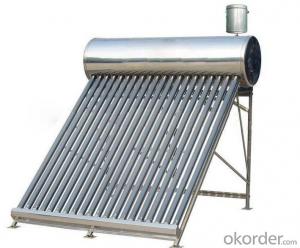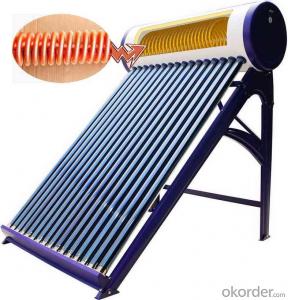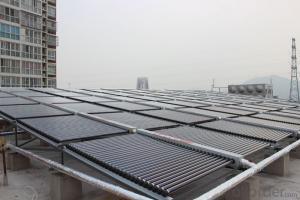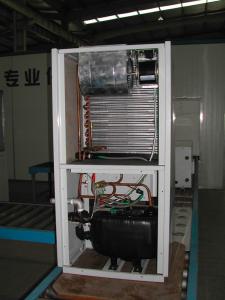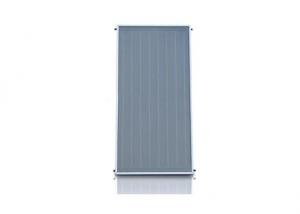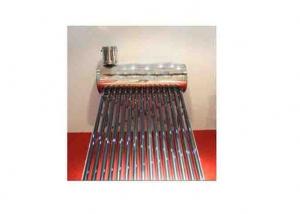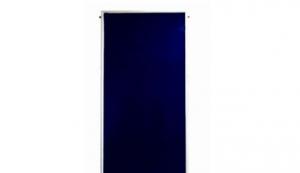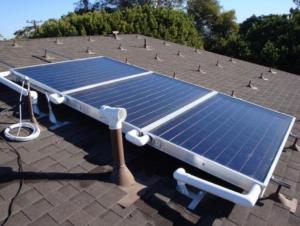Camping Solar Water Heater - High Quality Low Pressurized Vacuum Tube Solar Water Heater
- Loading Port:
- China Main Port
- Payment Terms:
- TT or LC
- Min Order Qty:
- 1 Set set
- Supply Capability:
- 3000 Sets per Week set/month
OKorder Service Pledge
OKorder Financial Service
You Might Also Like
Detailed Product Description
1, long company history
2, best configuration
3, perfect craft.
Thermosyphon Nonpressure Solar Hot Water Heating System for Household Use
Working Principle
1, The high quality vacuum tubes absorb the solar ultraviolet ray and then heat the cold water in it ;
2, The hot water rise in the ttop of tank and the cold sink to the bottom ,so as to form a circulation .
Description
It is designed for the special area or country , which located near to the equator such as INDIAN, PAKISTANT, THAILAND, EGYPT ETC.
Specification
Type | Vacuum Tubes | Capacity (L) | Loading Quantity (20'GP/40'GP/40'HQ) | |
No. | Dia. - Len. | |||
JJR-150-1800/58-15-NP | 15 | Ø58-1.8m | 150 | 42/89/105 |
JJR-160-1800/58-16-NP | 16 | Ø58-1.8m | 160 | 41/88/104 |
JJR-200-1800/58-20-NP | 20 | Ø58-1.8m | 200 | 35/74/86 |
JJR-240-1800/58-24-NP | 24 | Ø58-1.8m | 240 | 31/65/77 |
JJR-300-1800/58-30-NP | 30 | Ø58-1.8m | 300 | 26/54/64 |
- Q: Can a solar water heater be used in areas with high levels of minerals in the water?
- Yes, a solar water heater can be used in areas with high levels of minerals in the water. However, it is important to regularly maintain and clean the system to prevent mineral build-up that could potentially affect its efficiency and lifespan.
- Q: Can a solar water heater be used in areas with limited roof orientation options?
- Yes, a solar water heater can still be used in areas with limited roof orientation options. While it is ideal for a solar water heater to be installed on a roof with optimal sun exposure, there are alternative mounting options available. For instance, it can be installed on a wall or a ground-mounted system can be utilized. It is important to work with a professional to assess the specific situation and determine the best installation method for maximizing solar energy capture.
- Q: What is the average lifespan of the storage tank in a solar water heater?
- The average lifespan of a storage tank in a solar water heater can vary depending on various factors such as the quality of the tank, the materials used, proper maintenance, and the climate conditions it is exposed to. However, on average, a well-maintained and properly installed storage tank in a solar water heater can last anywhere from 10 to 20 years. Regular inspections, cleaning, and maintenance can help prolong the lifespan of the tank and ensure optimal performance. It is also important to consider the warranty and specifications provided by the manufacturer, as some tanks may have specific lifespans mentioned by the manufacturer.
- Q: Can a solar water heater be used in areas with limited access to building codes and regulations?
- Yes, a solar water heater can be used in areas with limited access to building codes and regulations. Solar water heaters are relatively simple systems that do not require extensive infrastructure or complex installations. They can be easily implemented in areas with limited building codes and regulations, providing a cost-effective and sustainable solution for heating water. However, it is important to ensure proper installation and maintenance to ensure optimal performance and safety.
- Q: Can a solar water heater be installed by a homeowner or does it require professional installation?
- A solar water heater can be installed by a homeowner, but it is generally recommended to have professional installation. While the basic installation process of a solar water heater is not overly complex, it still involves dealing with plumbing, electrical connections, and potentially structural modifications. By having a professional install the solar water heater, you can ensure that it is done correctly and according to local building codes and regulations. Additionally, professionals have the knowledge and experience to determine the best location for installation and to make any necessary adjustments or repairs. This will ultimately result in a more efficient and effective solar water heating system. However, if you have a good understanding of plumbing and electrical work, and feel confident in your abilities, you may choose to install a solar water heater yourself. In this case, it is important to thoroughly research and follow the manufacturer's instructions, as well as consult with local authorities to ensure compliance with any necessary permits or regulations.
- Q: Can a solar water heater be used in areas with high levels of noise pollution?
- Indeed, a solar water heater remains viable in regions plagued by high levels of noise pollution. The functionality or efficiency of a solar water heater is not compromised by noise pollution. Noise pollution primarily encompasses the irksome excess of noise emitted by vehicles, machinery, or human activities, which inconveniences residents in those areas. Nonetheless, solar water heaters operate silently, relying solely on sunlight to heat water. Consequently, noise pollution should not impede the installation or operation of a solar water heater in areas beset by high levels of noise pollution.
- Q: Can a solar water heater be used in areas with limited access to sustainable energy policies?
- Yes, a solar water heater can be used in areas with limited access to sustainable energy policies. Solar water heaters rely on the sun's energy to heat water, making them a sustainable and renewable option regardless of the local energy policies. They can provide hot water without the need for electricity or traditional fuel sources, making them a viable solution for areas with limited access to sustainable energy resources.
- Q: What is the required maintenance cost for a solar water heater over its lifespan?
- The required maintenance cost for a solar water heater over its lifespan can vary depending on several factors such as the quality of the system, local climate conditions, and usage patterns. However, in general, solar water heaters are known for their low maintenance requirements. Most manufacturers recommend an annual check-up to ensure proper functioning and efficiency, which may cost around $100 to $200. Additionally, occasional maintenance tasks like cleaning the collectors and replacing any faulty parts may incur additional costs. Overall, the average maintenance cost for a solar water heater over its lifespan can be estimated to be relatively minimal compared to the potential energy savings it provides.
- Q: Can a solar water heater be used in areas with limited access to carbon footprint calculations?
- Yes, a solar water heater can still be used in areas with limited access to carbon footprint calculations. The primary benefit of a solar water heater is its ability to utilize renewable energy from the sun, which reduces reliance on fossil fuels and lowers carbon emissions. Even without precise carbon footprint calculations, using a solar water heater can still contribute significantly to reducing environmental impact and promoting sustainability.
- Q: What are the advantages of using a solar water heater?
- There are several advantages to using a solar water heater. Firstly, it helps to reduce energy consumption and dependence on fossil fuels as it harnesses the sun's free and renewable energy. This can lead to significant cost savings on electricity or gas bills. Secondly, solar water heaters are environmentally friendly, producing lower greenhouse gas emissions compared to traditional water heaters. Additionally, they require minimal maintenance and have a longer lifespan, resulting in reduced overall costs and a smaller carbon footprint. Finally, solar water heaters can be a reliable source of hot water even during power outages, ensuring a continuous supply.
1. Manufacturer Overview
| Location | Zhejiang,China (Mainland) |
| Year Established | 2004 |
| Annual Output Value | US$10 Million - US$50 Million |
| Main Markets | North America; South America; Southeast Asia; Africa; Oceania; Mid East; Western Europe |
| Company Certifications | ISO 9001:2000 |
2. Manufacturer Certificates
| a) Certification Name | |
| Range | |
| Reference | |
| Validity Period |
3. Manufacturer Capability
| a) Trade Capacity | |
| Nearest Port | |
| Export Percentage | 61% - 70% |
| No.of Employees in Trade Department | |
| Language Spoken: | |
| b) Factory Information | |
| Factory Size: | 5,000-10,000 square meters |
| No. of Production Lines | 8 |
| Contract Manufacturing | OEM Service Offered |
| Product Price Range | |
Send your message to us
Camping Solar Water Heater - High Quality Low Pressurized Vacuum Tube Solar Water Heater
- Loading Port:
- China Main Port
- Payment Terms:
- TT or LC
- Min Order Qty:
- 1 Set set
- Supply Capability:
- 3000 Sets per Week set/month
OKorder Service Pledge
OKorder Financial Service
Similar products
Hot products
Hot Searches
Related keywords
